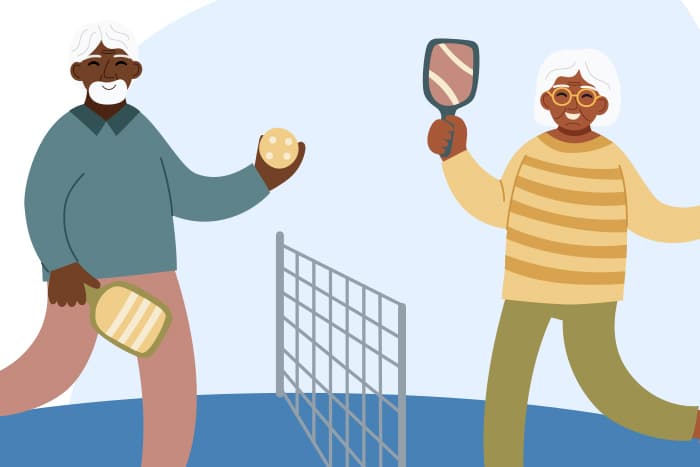Pickleball is a fast-paced sport that combines elements of tennis, badminton, and ping pong. Chances are, you’ve heard of the sport—its popularity has skyrocketed in recent years, and it’s been named the fastest-growing sport in the U.S. by the Sports and Fitness Industry Association for four consecutive years. While people of all ages enjoy pickleball as a pastime, it’s a particularly good choice for seniors, as it provides aerobic activity without significant stress on the joints and muscles. Let’s explore the health benefits of pickleball for seniors and how they can get started with the sport.
Key Health Benefits of Pickleball for Seniors
The benefits of pickleball for seniors range from physical to emotional. Read on to learn more about how this fun, approachable sport can support wellness in older adults.
Low-Impact Exercise
The game is less intense on the joints compared to many other sports, making it an ideal option for seniors who may have concerns about joint pain or injuries.
Improves Mental Health
Regular physical activity, such as pickleball, can help reduce stress, anxiety, and symptoms of depression. The social nature of the game also promotes a sense of community, which is vital for emotional well-being among older adults.
Supports Cardiovascular Health
Pickleball provides a moderate aerobic workout, helping to improve heart health, increase stamina, and reduce the risk of heart disease.
Enhances Balance and Coordination
Pickleball involves quick movements and changes in direction, which can improve balance, coordination, and agility. This is particularly important for seniors to prevent falls.
How Seniors Can Get Started with Pickleball
Due to its wide popularity and approachable nature, it’s easy for seniors to get started playing pickleball. Here’s what you need to know before you pick up your paddle.
Learn the Rules: Familiarize yourself with the basic rules of the game. Many online resources are available for this, or you can ask friends or family members familiar with the sport to teach you.
Get Your Gear: To play pickleball, you just need a paddle and a pickleball. Get started by browsing the approved paddle and ball list from USA Pickleball.
Find a Coach: If you’re completely new to the sport, consider lessons from a Professional Pickleball Registry-certified coach or a USA Pickleball Ambassador. If you’d prefer to keep the hobby as low-cost as possible, you can ask around for tutorials from friends, family, or other community members.
Choose a Court: Many senior centers, community parks, or other fitness locations have pickleball courts. USA Pickleball’s Places to Play list is a great place to start.
More Pickleball FAQs
Pickleball is a fun and safe activity for seniors to stay active and enjoy social interactions. Always consult a doctor if there are concerns about specific health conditions or risks before starting any new physical activity.
Yes, a 70-year-old can absolutely play pickleball! Pickleball is a low-impact sport, making it suitable for players of all ages, including seniors. It’s easier on the joints compared to other sports like tennis, but it still provides a great workout and social experience. Many seniors enjoy playing pickleball, and there are often age-appropriate leagues or divisions to accommodate different fitness levels.
According to the American Medical Association, the potential for pickleball injuries comes from overuse of specific joints or muscles. Because the game involves sudden movements, quick direction changes, and repetitive actions, it’s important to warm up properly and focus on stretching, strengthening, and joint protection to minimize the risk of injury.
Pickleball was invented in 1965 by Joel Pritchard, Bill Bell, and Barney McCallum on Bainbridge Island, Washington. It’s now about 60 years old and has become one of the fastest-growing sports in the United States and worldwide.
Pickleball is an excellent form of exercise. It provides cardiovascular benefits, improves balance and coordination, strengthens muscles, and enhances flexibility. It’s a full-body workout that’s low-impact, making it ideal for those who want to stay active while minimizing the risk of injury.

